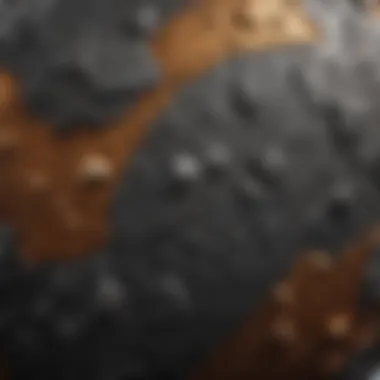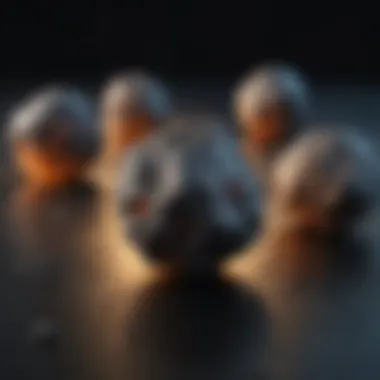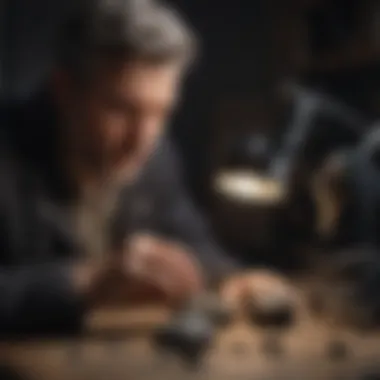Exploring Round Meteorites: Formation and Significance


Intro
Round meteorites cue intrigue and scientific wonder. A meteorite’s journey from space to Earth provides critical insights into our solar system’s formation. The process begins with a meteoroid entering our atmosphere, resulting in various forms. Contrary to their more irregular-shaped counterparts, round meteorites exhibit unique characteristics worthy of detailed exploration.
Understanding their formation, classification, and geological implications elevates both amateur and professional enthusiasm within geological studies. By shedding light on round meteorites, this article aims to inform collectors on not only their scientific significance but also on practical collecting tips, preservation methods, and display techniques. This exploration starts with rock and fossil identification, a key aspect for anyone involved in studying meteorites.
Rock and Fossil Identification
Identification is the first crucial step for any collector or enthusiast trying to understand round meteorites. Knowledge of the multiple types and characteristics can elevate collecting from mere hobby to intense science.
Types of Meteorites
Meteorites generally fall into several categories:
- Chondrites: Formed from particles that condensed from the solar nebula, they exemplify some of the solar system's oldest material.
- Achondrites: These originate from differentiated bodies, providing insight into cooling processes in planetary bodies.
- Iron Meteorites: Composed mostly of metal, these offer a glimpse into the cores of now-obliterated asteroid bodies.
Characteristics to Look For
To identify meteorites, collectors should seek specific features:
- Density: Meteorites can feel notably heavier than ordinary rocks due to high metal content.
- Exterior Texture: A fusion crust—a thin, dark layer formed by atmospheric entry—often coats meteorites. This is usually a telltale sign.
- Magnetism: Many meteorites can be attracted to magnets. Always carry a magnet during field checks to assist with identification.
With knowledge on types and characteristics in hand, the next section delves into effective collecting tips and techniques.
Understanding Meteorites
Meteorites, remnants of ancient celestial bodies, provide key insights into the formation and evolution of our solar system. Studying these objects is essential for comprehending not just planetary processes but also the historical dynamics of our universe. Round meteorites, in particular, garner interest due to their unique characteristics and implications for planetary geology and formation theories.
Definition of Meteorites
Meteorites are solid fragments that survive their passage through Earth’s atmosphere. They originate from various celestial bodies, including asteroids and planets. Once a meteoroid enters the atmosphere and survives to reach the ground, it is classified as a meteorite. The distinction lies in their nature; meteoroids are essentially the nondescript fragments floating in space, while meteorites are those that endure the trials of atmospheric entry.
Separating meteorites into diverse categories—like stony, iron, and stony-iron—sheds light on their composition. Identifying whether a meteorite is round or irregularly shaped can also suggest its formation process, adding further depth to our understanding.
Historical Perspectives
Throughout history, meteorites have fueled both fascination and scientifically fruitful inquiries. In ancient times, these celestial rocks were often interpreted as divine omens or messages from the heavens. The historical view of meteorites shifted during the Enlightenment, as thinkers began to grasp their physical properties and origins through methodical observation.
Notably, the Iron Meteorite discovered in the village of Obryanovka in 1866 showed that some space materials share properties with earthly metals, dispelling previous mythologies. As more findigs were made, the scientific valuation of these objects soared.
In the modern era, round meteorites like the Allende meteorite have provided invaluable data regarding the earliest materials from which the solar system formed. They have played pivotal roles in discussions about planetary formation and evolution. Researchers continue to explore their histories and attributes — challenging our understanding and opening new discussions about the universe and our planet.
Characteristics of Round Meteorites
Understanding the characteristics of round meteorites is essential to gain a comprehensive knowledge of these celestial objects. Their distinct properties reveal valuable insights into their origins and potential applications in various scientific and collector contexts.
Physical Properties
Size and Shape Variability
The variability in size and shape is a key aspect of round meteorite characteristics. This variability enhances the aextent of study, as it allows researchers and collectors to observe various forms and dimensions that round meteorites can take. Some specimens may be small enough to fit in the palm of a hand, while others can exceed several kilograms.
The round shape often signifies the means by which these meteorites have managed to withstand the travails of space travel, from atmospheric entry to landfalls on Earth.
Unique Feature: The initial formation of roundness can present advantages in studies of glacial movement. Large specimens have different strengths and weaknesses, leading to flawed assumptions about their durability. In research settings, comparing round meteorites aids scientists in addressing larger questions about physical sustainability.
Surface Texture Analysis
The analysis of surface texture is crucial in distinguishing among various meteorite types. Surface features can provide clues on the environmental history of a meteorite. Some have a smooth surface, while others exhibit pitted textures or encrustations.


Key Characteristic: These textures serve collective purposes. While studying surface textures indicates previous exposure to cosmic events, it also assists collectors in judging the authenticity and age of specimens. The surfaces reveal storied histories invisible to the naked eye.
However, texture also brings challenges. Features may be obscured by crusting or oxidation, which complicates the accurate assessment. Recognizing various types of textures is important before acquisition as part of discussions on the quality of the specimen.
Chemical Composition
Common Minerals in Round Meteorites
Investigating the mineral composition of meteoric samples helps characterize them through various analytic techniques. Common minerals include olivine, pyroxene, and iron, which contribute to the meteorite’s whole-being.
Why important: The elemental presence can directly influence valuations. Specific minerals can enhance the desirability and aesthetics for collectors and researchers alike. Additionally, varying proportions among these minerals can provide insight into the development and differentiation behavior of their parent bodies.
Within scientific study, changes in mineral composition across specimens can lead to advancements in our understanding of celestial conditions during their formation periods.
Trace Elements and Isotopes
Tracng elements and studying isotopic ratios allow a detailed indication of a meteorite's process, journey, and origin. Elements like titanium or uranium can hint at formation environments.
Such useful differences provide extreme hints into not just the meteorways but even the potential reflects distribution resources in planetary bodies.
Considering isotopes aids the reconstruction of planetary maters types, which contribute crucially to theories on aug mythology and Earth-Moon rotations.
The presence of these elements envisions enriched discussions around origins of meteorites and, by hydrogen counts, lifting definitive implications survival and characteristics analysis of interplanetary bodies.
Advanced study of round meteorite substances directly relates to tangible scientific fields, enhancing information factored down from astronomical innovation decline.
Formation Processes
The formation processes of round meteorites provide crucial insight into how these unique specimens come to exist. Understanding these processes not only enriches the scientific narrative but also allows collectors to better appreciate the complex nature of these items. Various mechanisms contribute to the shaping and characteristics of round meteorites. In this section, we will explore these mechanisms, including ablation during atmospheric entry and collisional rounding in space, alongside their geological implications.
Mechanisms of Roundness
Ablation During Atmospheric Entry
Ablation plays a significant role in determining the round shape of meteorites. This occurs when a meteorite enters the Earth's atmosphere at high speeds. As it travels, the intense heat causes the outer layers to vaporize and peel away. This process creates a smooth, round surface which is can be an indicator of the meteorite's entry velocity and angle. A significant characteristic of ablation during atmospheric entry is its ability to completely reshape the outer layer of the meteorite, leading to varied textures and surface features.
The fact that ablation is universally present among meteorites gives it a beneficial aspect for this article. It serves as a common factor that enhances the understanding of various meteorites' physical appearance. However, a disadvantage could arise in cases where excessive ablation reduces the sample to mere tiny fragments, resulting in challenges for those studying larger meteorite types.
Collisional Rounding in Space
Collisional rounding in space refers to another mechanism contributing to roundness, occurring early in the life of meteoroids in the asteroid belt. During this phase, impacts between cosmic bodies can fracture and break apart surfaces. Continual collisions can lead to gradual smoothing of edges, creating spheres or near-spherical shapes. The key characteristic here is the ongoing nature of these interactions, where proximity to other space bodies influences the degree of rounding.
This process carries interesing implications for collectors as it helps trace back the meteorite's journey through the solar system. However, its downside is that it may produce surface layers battered by collisions, leading to heterogeneous characteristics on the specimen’s surface.
Geological Implications
The geological implications of round meteorites are profound. They are not mere pieces of rock; they are rare insights into early solar system conditions. Studying their formation processes opens up conversations about the nature of planetary bodies and the conditions required for such meteoric structures to exist. These processes also enhance understanding about the heat and pressure dynamics in space, shedding light on the early conditions that gave rise to planets.
Overall, formation processes are essential for appreciating the complexities surrounding round meteorites. The insights provided through this analysis are of paramount interest to both professionals studying their characteristics, as well as enthusiasts engaged in collectible communities.
Classification of Round Meteorites
Classification of round meteorites provides a structured method for understanding these celestial objects. With their unique attributes and implications for research, categorizing round meteorites is essential for collectors and scientists alike. Knowledge of their classifications helps in appreciation and evaluation, forming a foundation for further studies.
Categorical Framework
Stony Meteorites
Stony meteorites represent the most common category, comprising about 94% of meteorite finds. Their significance lies in conveying information about the early solar system. A key characteristic is their composition, predominantly silicate minerals like olivine and pyroxene.


They are popular among collectors for their relative abundance and diverse appearances, making each specimen a distinctive addition. One unique feature of stony meteorites is the presence of chondrules—spherical inclusions formed in the solar nebula.
While they enable insight into the meteorite's origin, distinguishing features may make classification tricky, requiring careful examination.
Iron Meteorites
Iron meteorites consist primarily of iron and nickel. Their importance come from what they reveal about the differentiated bodies in the solar system. One striking aspect is their dense nature; their unique metallic luster makes these meteorites appealing to collectors.
They are relatively easy to identify due to chemical composition, often featuring Widmanstätten patterns which are distinctive internal structures formed through slow cooling. Their key uniqueness provides insights but can also challenge collectors with potential rust concerns.
Stony-Iron Meteorites
Stony-iron meteorites contain both silicate minerals and metallic elements. The significance lies in their dual nature, providing insights into processes that shape celestial bodies. Their composition offers a richer research arena, combining features of both stony and iron types.
A remarkable characteristic is the equal mix of metallic and non-metallic materials, making them visually appealing. Collectors favor these specimens for their rarity and aesthetic appeal. Their main disadvantage might include higher prices and reduced availability.
Notable Examples
Brenham Meteorite
The Brenham meteorite is particularly notable due to its fascinating history and analysis on Earth. It is classified as a stony-iron meteorite, revealing a blend of olivine and nickel-iron. Its discovery site in Kansas, USA adds allure, often motivating researchers and collectors to explore its origins.
A critical aspect that makes it attractive for study is that it represents the complex history of collisions and transformation experienced in the solar system. However, it standouts mainly due to fragmentation which may limit complete specimens.
Allende Meteorite
The Allende meteorite made headlines as one of the largest carbonaceous chondrites. Its key characteristic is the extensive presence of organic compounds and allene-intrusive minerals, providing insights into solar and planetary formation. It landed in Mexico in 1969, fascinating researchers.
The information unpacked through its chemical components contributes greatly to ongoing studies in astrophysics. Yet, enthusiasts may find the complex nature of its variants, such as texture and composition, somewhat challenging for straightforward classification and appreciation.
Understanding the classification of round meteorites enriches both scientific exploration and personal collections, illuminating our understanding of the cosmos.
Significance in Research
Round meteorites hold a special place in scientific research. Their unique characteristics offer insights that not only expand our knowledge of celestial bodies but also elucidate histories embedded deep in their structures. The study of these meteorites transcends discipline, intertwining the fields of geology, astronomy, and planetary science. Understanding their significance helps scientists piece together the puzzle of our solar system's formation and evolution.
Astrophysical Insights
Examining round meteorites provides profound astrophysical insights. These meteorites often originate from asteroids, and their compositions can reveal conditions present in the early solar system. By analyzing isotopic ratios, researchers can infer the timeline and mechanisms through which these celestial bodies formed. This exploration covers points such as:
- Identification of Ancient Materials: Certain minerals found in meteorites date back billions of years, illuminating processes from the solar system's infancy. Identifying these ancient materials is crucial for understanding the genesis of planetary bodies.
- Radioactive Dating: Isotopic studies enable scientists to ascertain the age of meteorites, contributing to broader knowledge about the timeline of cosmic events.
- Cosmic Radiation Effects: Analyzing cosmic ray exposure within round meteorites helps to elucidate the solar environment and variations over time, yielding insights into solar activities.
Collecting Round Meteorites
Collecting round meteorites signifies an essential element within the broader discussion of meteorite study. For enthusiasts and researchers alike, these specimens offer not just aesthetic appeal, but also the opportunity to gain deeper insights into planetary formation and celestial processes. Round meteorites, with their unique physical characteristics, invite both scientific inquiry and personal connection. They serve as tangible connections to the cosmos, appealing to both serious collectors and casual admirers.
Ethical Considerations
Understanding the ethical implications of collecting round meteorites is crucial in today’s context. The responsible collection of meteorites respects the rules of various countries as well as local laws governing the extraction of natural materials. Collectors must be aware of the origin of meteorites, ensuring their samples are sourced through legal and ethical channels.
Considerations for collectors include:
- Provenance: It’s important to verify the history of a meteorite. Knowing where it came from is vital for both scientific integrity and as assurance for future buyers. Weather natural find or purchased, thorough documentation is respectful of the science community.
- Impact on Sites: Taking meteorites from sensitive areas may disrupt their local ecosystems and histories. Educational responsibility is key here.
- Cultural Sensitivities: Some communities have deep affiliations with meteorites or their mining locations. Sensitivity toward cultural beliefs is paramount when considering international collecting.
Ethics in meteorite collection emphasizes not just collecting for personal enrichment but also emphasizes responsibility toward the scientific community and planetary resources.
Care and Preservation
Proper care and preservation of round meteorites ensure these unique specimens remain in optimal condition. Tend to these meteorites diligently to appreciate their features effectively and retain their value over time.


Storage Guidelines
Storage contributes significantly to a round meteorite’s longevity. It involves sheltering these specimens in environments protected from humidity and UV exposure. Ideally, meteorites should be housed in controlled temperature environments.
Key Characteristics:
- Container Type: Use non-conductive display materials like acrylic boxes or glass containers. These approaches enhance visibility while offering necessary resilience against physical damage.
- Humidity Control: Utilizing silica gel packets within the storage containers absorbs excess moisture that could incur corrosion.
A positive angle of these storage guidelines is their simplicity. Easy to implement, they form a beneficial choice for both professional and amateur collectors. The main disadvantage may arise when space is limited; sophisticated arrangements might require additional space in homes.
Cleaning Practices
Cleaning practices also play an integral role in maintaining the integrity of round meteorites. Regular maintenance distinctively contributes to the understanding of meteorites, emphasizing your commitment as a collector.
Key Characteristics:
- Gentle Mechanics: Use soft brushes or non-abrasive cloths, paired with distilled water when necessary to prevent damage.
- Avoiding Chemicals: Household cleaning products can negatively affect these specimens; hence, sticking to basic cleaning brokers keeps their surface intact.
Implementing effective cleaning methods is a popular choice for dedicated collectors. While cleaning can enhance the meteorite’s visibility, caution is necessary to cherish each specimen and eliminate risks entirely. Too much intervention may result in surface alteration, affecting both aesthetic appeal and potential resale value.
Ultimately, protecting and collecting round meteorites requires meticulous care, ethical responsibility, and appropriate maintenance to provide future enjoyment and understanding within the fascinating niche of astrophysics and planetary science.
Market Trends and Valuation
Understanding the market trends and valuation dynamics of round meteorites is a crucial aspect for collectors and researchers alike. The commercial value of these extraterrestrial materials might fluctuate based on various factors such as rarity, demand, and historical significance. Knowing these elements helps collectors make informed decisions when acquiring or selling specimens.
Having insights into market trends facilitates not only financial investments but also eoaches an appreciation for the science behind these celestial objects. This conevys a valuable perspective for enthusiasts dedicated to the collection of meteorites.
Understanding Worth
When examining the worth of round meteorites, several key aspects merit attention. The value is often determined by various criteria, including:
- Rarity: Some meteorites are relatively abundant, while others are exceptionally rare. The more elusive a specimen, the higher its potential value when it comes to the market.
- Historical Significance: Specific meteorites carry unique stories or are associated with historic events that can drive up their worth.
- Physical Characteristics: The size, shape, and surface texture impact valuation. Round meteorites, due to their shape, often generate interest from collectors willing to pay a premium.
- Provenance: A documented history of where the meteorite was sourced, including any expert evaluations, significantly influences its market prospect.
It's essential for collectors to analyze both current market values and past sale records to gauge trends effectively.
Auction Insights
Auctions play a pivotal role in determining the market rate for round meteorites. They provide a unique platform for both collectors and sellers to assess the live demand and competition. Here are some key insights on participating in meteorite auctions:
- Targeting Reputable Auctions: Not all auctions offer the same credibility. It is critical to focus on venues known for their specialized catering to meteorites, such as Bonhams or Sotheby's.
- Price Realization: Observing the auction prices of similar meteorites can help prospective buyers ascertain what constitutes a desirable value.
- Sneak Previews: Many auctions provide previews for prospective buyers and allow for examination. This process fosters confidence before purchase and may impact bidding strategies.
- Engaging Buyers: Sellers need effective marketing tactics to reach the right audience, promoting key features of the meteorite to enhance interest and bidding enthusiasm.
Collectors who actively track auction results are better equipped to navigate market fluctuations and select promising specimens for their collections.
Thus, grasping market trends and the intricacies of auction processes can empower collectors not only to appreciate but also to intelligently engage with this unique field.
Epilogue and Future Directions
Summary of Key Findings
In this article, the study of round meteorites uncovered several critical insights. First, round meteorites are notably characterized by their unique physical properties, which might result from various formation processes. These processes include ablation during atmospheric entry and collisional rounding in space
Additionally, their chemical composition reveals a variety of minerals and elemental isotopes that provide vital information about their origins in the solar system. Understanding these elements assists researchers in sorting and classifying round meteorites correctly, enriching the currently accepted frameworks.
Third, the significance of these bodies goes beyond purely academic interests. They hold value in both research and the collector community. Such meteorites can reveal much about the early conditions of the solar system. Moreover, insights into planetary formation theories stem from findings involving their peculiar behaviors and properties.
Lastly, natural resource ethics must guide the collection practices surrounding these valuable specimens. Responsible storage, preservation, and care ensure that both institutional and private collections can be sustained for future generations.
Seeking New Discoveries
Future research surrounding round meteorites eye several promising pathways. With increased advances in technology, researchers are set to make greater discoveries that could redefine our understanding of these celestial collections. Potential areas of focus include:
- Analytical Techniques: Utilizing new techniques can enhance the precision of isotopic analyses, leading to deeper insights into the formations and conditions of meteorites.
- Field Expeditions: As space exploration continues, future missions aim to safely sample otherwise unreachable bodies. These samples stand to provide groundbreaking evidence regarding event processes
- Collaboration: Intellectual collaboration born from insights across planetary sciences, geology, and astrobiology could lead to significant revelations about Earth's and other planetary bodies' early history.
Thus, as we delve further into this impressive field, a multitude of new findings may emerge that could change vested perspectives and approaches in meteorite studies. With persistent dedication, enthusiasts and professionals alike may unravel complex mysteries left by round meteorites.







